#people doing not just traditional but whats common. different classes. different regions
Explore tagged Tumblr posts
Text
the hatsune miku trend rn where everyones drawing her as their own culture or where they're from is oddly kinda healing after seeing so much AI slop the past several months--its horrid on pinterest, its overwhelming and despairing.
But its refreshing to see so much feeling behind such personal designs of Miku, seeing real people's nostalgia and pride shine through, no two people from the same location will draw her the same, they'll give her their own childhood
am i crazy
#IDK I LOVE IT MY LIKES R FULL.. .MY QUEUE.....#she rly is like barbie yknow#so many different places#people doing not just traditional but whats common. different classes. different regions#ive seen people from the states do it too. i'd like to see uh like... northwest miku lmao...#hatsune miku
981 notes
·
View notes
Text
some misc worldbuilding questions to get your gears turning:
Do they have germ theory or some equivalent? How do they conceptualize the spread of disease and infection?
Is the everyday economy based more on trade/barter or currency? Is the currency valuable in its own right, or is it just something agreed upon to have value (eg. salt or gold vs. paper money)
What is their main method of lighting? What resources does this use?
Primary mode of transportation? How much does this vary based on things like purpose of travel, social class, etc.?
How much of a knowledge/education gap is there between social classes? Is there a baseline of education that everyone gets/is expected to have?
What are the most popular modes of storytelling? Is everyone telling campfire stories? Are they going to plays? puppet shows? are they going to the cinema? are they reading novels or epic poetry? Are there any folk characters or pop culture things that most people are familiar with?
Where does most people's moral framework primarily come from? Religion? Philosophy? Are there different schools of thought? How much do they vary?
Is there anything considered scandalous/improper/taboo that's normal in your own culture? and vice versa
Do most people live and die where they are born, or is it common to relocate and travel widely? how much does this vary by class/profession/region?
What do they do with criminals? Do they have an extensive prison system? If so, who funds/runs it? If not, how is crime discouraged/managed? Are there specific punishments for specific crimes?
How rigid are their class boundaries? How possible/common is it for someone to change social classes?
Is there anything that people get dangerously addicted to in your world? How accessible is it?
How easy is it for someone to do research/look up information they don't know? What is the primary method of doing this?
What holidays do they have? Any weird traditions? Fun traditions? Are they universally celebrated, or only by specific groups of people?
How do they dispose of their dead? How do they honor their dead?
How much exchange is there between cultures? Do people of different groups intermingle, or do they mostly stick with their own people?
How common is it to speak more than one language, and who is most likely to be multilingual?
How much do regional dialects/accents vary within the same language? Are there any dialects/accents that are stigmatized? Do different accents have different associated stereotypes?
This isn't meant to be taken as a checklist that you have to completely fill out btw. Just things that might help add flavor to your world and characters. (Also mostly things I end up thinking about logistically anyway as they become relevant to the plot or a character's frame of reference.) Enjoy!
594 notes
·
View notes
Note
I really can’t take the “mudblood” insult that seriously. I see people in the fandom comparing it to racial slurs, but Wizard “blood status” isn’t the same as race, it’s a aristocratic class hierarchy. So calling someone a “mudblood” just sounds like a mean way of calling someone peasant or pleb.
In my country, Spain, many regions have their own languages and cultures, and there is a variety of nationalist movements regarding this. Some are more peaceful, while others have had armed terrorist groups that carried out attacks against civilians, and others simply opt for institutional approaches with the government.
Both of my parents are left-wing catalan nationalists because it was common among young people from families that spoke the language during the 1970s, at the end of the dictatorship (which heavily oppressed languages other than Spanish and promoted absolute centralism and repression of other internal cultures) and during the transition to democracy. My parents are quite different in terms of character and life perspectives, but they strongly agree on this point: our language and culture must be preserved above all else, and they see Spanish as a "threat."
My parents are leftist, very progressive, and people who, in their time, were way ahead of their era. They taught me from a young age to normalize many social issues that were considered rare at the time. But still, every time I’ve mentioned a guy I’m dating or have met, the questions are always the same: Does his family speak the language? Does he speak it at home? Do his parents speak it? And beyond that, they’ve even asked if the surnames are of Catalan origin. Because this is very common among families that prioritize the preservation of language and regional culture: knowing whether a surname is regional or not.
My father wouldn’t mind if his grandchildren had a Galician or Basque surname if it couldn’t be Catalan, but a Spanish surname? I know he wouldn’t oppose it, but he wouldn’t be thrilled about it. My mother wouldn’t oppose it either, of course, but I know that if I end up with a long-term partner whose family is not bilingual and doesn’t have our traditions, but instead comes from a "Castilianized" family, she wouldn’t be entirely happy. Because that’s how nationalist thinking works in a minority that wants to preserve its customs and way of life—even if there’s no conscious prejudice or discrimination, there’s a desire for one’s children to marry people with surnames from their culture, to speak their language, and to have families of the same background. Or, if not exactly from their language, at least from other regions with minority cultures, because that way, the culture is perpetuated, and it also feels like a way to push back against the dominant culture that tries to absorb the others.
What I mean by this is that the issue of blood purity in the HP universe has always felt very similar to the nationalist mindset I’m talking about: a social minority with its own customs and traditions that feels threatened by the increasing dominance of people who don’t belong to that same culture and who, moreover, pose a risk to their customs. These are very closed communities that want to preserve a certain "purity" in their descendants—not at a racial level but for an intrinsically cultural reason.
We’re not talking about a structure of economic and political oppression in which these communities have systematically oppressed others. There has been no plundering of their lands, no trafficking of people, no dehumanization that led to slavery. There has been no entire social, economic, and cultural framework that relegated Muggle-borns to being treated as less than animals. Muggle-borns have had rights from the very beginning: they could move freely in the magical world, enter the same shops, go to the same banks, and eat in the same places as pure-bloods. They could marry pure-bloods without issue. There have been no laws granting pure-bloods political authority over Muggle-borns. They have been equals under the law and have had the same rights. They have been able to study at the same school, share the same common room, dormitories, and dining hall. They have been able to access jobs, become professors, or work at the Ministry.
There is absolutely no racist-based country where, before civil rights movements, racialized people were on the same level as white people as political subjects. Therefore, comparing blood purity to racism is completely inaccurate. Doing so is simplistic, ignorant, and disrespectful. Blood purity has much more in common with European nationalist movements like the ones I’ve mentioned—those with an independence-based background in their own countries.
My mother and father probably have nothing in common with Lucius and Narcissa in terms of their worldview since the Malfoys are conservative aristocrats, but they do share one key trait: they clearly have their preferences. My mother would rather see me with a right-wing person from a Catalan-Valencian, Basque, or Galician family than with a "castizo" Spaniard—just as the Malfoys would likely prefer their son to be with Ginny Weasley rather than a Muggle-born.
This is why many people compare the Death Eaters to the IRA in the 90s. To me, they resemble the nationalist terrorist group ETA here in Spain far more.
I’m sorry, but no, they are not the KKK. That’s an entirely Americanized view that has nothing to do with the social and cultural context of 90s Britain or Europe in general. Americans who don’t understand the social and political dynamics of late-20th-century Europe should just keep their mouths shut—because not everything revolves around their sociocultural context. Libraries are free, and opening a history book doesn’t cost money.
#blood purity#mudblood#muggle born#muggles#wizards and mugles#wizarding world#wizards#pure blood#death eaters#harry potter#harry potter world#harry potter meta
52 notes
·
View notes
Text
So, You Wanna Know About?: The Evil Eye
The concept of the “evil eye” exists in virtually every culture worldwide, as do amulets such as the nazar and hamsa. It's a fundamental part of most folk groups' magic and culture, which is why we use it as a symbol for our server. But what do we know about this concept and the symbols and practices surrounding it? Let’s take a second and explore.
What Exactly Is The Evil Eye?
In simplest terms, the evil eye is “a curse transmitted through a malicious glare, usually one inspired by envy.” [1] It's believed that this glare can cause misfortune, illness, injury, death, and general misery. [3] Pregnant women, infants, young children, and animals are thought to be especially susceptible. [4]
The Evil Eye’s First Appearance
Historians are unsure of the exact date the evil eye and amulets used to ward them off were invented, however, we can find examples going as far back as ancient Mesopotamia. Texts have been found in Ugarit (located in modern-day Syria) attesting to the concept until roughly 1180 BC. [2] According to Dr Nese Yildiran, “The earliest version of eye amulets goes back to 3,300 BC … The amulets had been excavated in Tell Brak, one of the oldest cities of Mesopotamia – modern-day Syria. They were in the form of some abstract alabaster idols made with incised eyes.” [1]
The Evil Eye Travels
Various things across history such as trade, travel, colonization, and immigration have caused the evil eye to travel the world. It spread through the SWANA region at first, but soon traveled to all continents worldwide: “[The evil eye has] occurred in ancient Greece and Rome, in Jewish, Islamic, Buddhist, and Hindu traditions ... [and in] Indigenous, peasant, and other folk societies.” [4] Historians have found it difficult to trace exact lines of transmission of the idea, but it notably seemed to spread rapidly among the common folk or working class. [5] It wasn't long before its presence became known across all continents, though it has always varied across time and space. For example “In Roman times, not only were individuals considered to possess the power of the evil eye but whole tribes…were believed to be transmitters of the evil eye.” [6] This is very different from how the evil eye exists in the current regions of the previous Roman Empire, as these tribes no longer exist.
It Came With The Amulets!
One of the earliest amulets associated with the evil eye is the nazar. Its name comes from the Arabic “نَظَر” (naðˤar) meaning “sight,” with many other languages adopting this term or creating their own. [7] The blue eye-shaped bead most commonly associated with this particular amulet is “made of a mixture of molten glass, iron, copper, water, and salt, ingredients that are thought to shield people from evil.” [8] Its blue color may be because “blue eyes are relatively rare [in the SWANA region], so the ancients believed that people with light eyes, particularly blue eyes, could curse you with just one look. This belief is so ancient, even the Assyrians had turquoise and blue-eye amulets.” [9] A similar amulet adopted from the nazar is the hamsa, similarly originating in the SWANA region. [10] The two have become perhaps the most widespread and well-known amulets, though they are certainly not the only ones.
Evil Eye Across Cultures & Religions
NOTE: this is not an exhaustive list, but a jumping off point.
Judaism: The evil eye can be found across various Jewish literature, from the Tanakh to the Talmud, and even books like Pikeri Avot. [11] It’s known best as the “ayin hara” which is Hebrew for the evil eye, though it may have different names across diaspora (for example, in Jewish-Spanish languages like Ladino it might be known as “Mal de Ojo”) [12] There are various customs to protect one from the evil eye across the Jewish diaspora, such as neckbands worn by boys for their brit milah, in the regions of Alsace, Southern Germany, and Switzerland just to name one. [13] One of our Jewish server members, Yosef, says “I'm Jewish and have been all my life ... my family is eastern European and we have gone to orthodox shul and (no) evil eye and other related symbols are prevalent in my family's practice along with the practice of my synagogues ... as such I constantly carry around the symbol”
Islam: The evil eye as a concept in Islam, known as the “al-ʽayn” is common. It's believed to destroy one's good fortune or cause illness. [14] Various phrases including “Mashallah” (God has willed it) are used to ward off the evil eye – “The imperativeness of warding this all too evident evil eye off is common among local communities. Not only did the absence of a “mashallah” tempt fate but it is also believed certain individuals have the power to conjure up the dark forces of the evil eye.” [15]
Italy: The evil eye in Italian is known as the “mal’occhio.” [16] In some regions, the cornicello ("little horn") is an amulet used to ward off the evil eye. It comes from Naples and it’s usually made of red coral and pepper shaped. [17] According to Antonio Pagliarulo, “some families, depending on the region of Italy from which they come, will pin the amulet to a baby's clothing either immediately before or immediately after his or her baptism.” [18]
Ireland: In Ireland, the evil eye is known as “Droch-shúil.” [19] There are a few various Irish folktales about the presence of the evil eye that warn of its dangers. One example is the tale of King Balor. The tale goes that “Balor was a king of the Formorians, the ancient inhabitants of Ireland (before the coming of the Tuatha Dé Danann). He is often described as a giant with a huge eye in the middle of his forehead. This eye brought death and destruction [onto] anyone he cast his gaze upon. He had gained this power from peering into a cauldron that contained a powerful spell that was being created by some druids. The vapors from the cauldron got into his eye when he looked inside which gave him the power of his deathly gaze. The most memorable instance of Balor using his eye is the story of his death at the battle of Maigh Tuireadh. In this famous battle between the Formorians and the Tuatha Dé Danann, Balor fell in battle at the hands of his own grandson, the pan-Celtic god Lugh, when he thrust his spear (or sling depending on the telling) through the eye of the giant. His eye was blown out the back of his head, turning his deadly gaze on his own men, destroying the forces of the Formorians. A piece of Dindseanchas (meaning lore of places) tells us that the place where his head fell and burned a hole in the ground, later filled with water and became known as “Lough na Suil” or “The Lake of the Eye”. Interestingly, this lake disappears every few years when it drains into a sinkhole. Local mythology says that this happens to ensure that the atrocities of the battle may never be forgotten.” [20]
Germany: In German, the evil eye is known as the “Bölser Blick”, something that is cured by a variety of methods such as red string, prayer, salt, iron, and incense. [21]
Poland: In Poland the evil eye is called "złe oko" or "złe spojrzenie." [23] In some regions, they use amulets known as "czarownica" which are charms often made from herbs, metals, or stones, or specific gestures believed to ward off the evil eye. In many Polish homes, you might find them hanging on the walls. A ‘czarownica’ might also be a necklace with a pendant crafted from amber, which is believed to ward off negative energy. [22] There are also folk tales about the evil eye, such as “an archaic Polish folk tale that tells of a man whose gaze was such a potent carrier of the curse that he resorted to cutting out his own eyes rather than continuing to spread misfortune to his loved ones” [1]
Russia: In Russian the evil eye is called "дурной глаз" or just "сглаз." [23] Some Russians ward off the evil eye by bathing in running water, which carries the negativity away. Fire is also used, with young people jumping over a campfire to remove bad energy. Carrying salt or pinning the fabric of your clothing are also other simple ways to ward off the evil eye. [24]
Mexico: In Mexican culture, the evil eye (el ojo) is thought to be especially prevalent during November around the time of Dia de los Muertos, with children being particularly susceptible. There are various ways a child may get the evil eye such as from a stare of a drunk or angry person, or a person who is "caloroso," or overheated from working out in a hot environment such as under the sun or cooking over a hot stove. [25] Some may use an ojo de venado, or “eye of the deer” as a protective charm, which is only effective if “worn as an amulet around the neck at all times.” [26] As a quote from one of our staff members, Ezekiel: “I was raised in a very Hispanic area so we all wore evil eye bracelets most of the time woven from the flea market… In Mexico or some parts of Latin America, it is called El mal de ojo and it is believed that different colored evil eyes do different things.”
Rroma: The concept of the evil eye also exists amongst the Rromani people. For Rroma in Slovakia, the belief in jakhendar is prevalent, often being diagnosed and cured with jagalo paňi, or ‘coal water’ [27] Rroma in places like Brno are also thought to be particularly susceptible to the evil eye, leading to communities to find members to help protect themselves. According to scholar Eva Figurová, “This role, instead, is appointed to the village shepherd, blacksmith, or other person perceived by the community as gifted with the ability to heal, cure, and ward off the effects of negative forces, whether intentionally or not. Nowadays, among the Roma in Brno, the chanting of the zoči is a common ritual that does not require the presence of a specialist.” [28]
India: In many parts of India, people use a nazar battu to ward off the evil eye, or the buri nazar. [29] Other methods of warding off the evil eye include hanging a drishti bommai [30], mothers spitting on their children [31], or marking them with a black mark on the cheek. [32]
Ethiopia: In Ethiopian culture, the evil eye is known as the "buda." [33] It is thought to be wielded by certain people (i.e. metalworkers) and warded off by amulets created by a debtera, or unordained priest. [34]
Conclusion
This blog post only begins to touch the surface when it comes to the evil eye. The history across time and space is so expensive one can truly dedicate their entire lives to studying and still not know everything there is to know. We sincerely hope that we have provided some perspective and gave some jumping off points for further exploration.
Sources & Further Reading:
Hargitai, Quinn (2018). “The strange power of the ‘evil eye’”. BBC. https://www.bbc.com/culture/article/20180216-the-strange-power-of-the-evil-eye. Accessed 1 Nov. 2024.
Pardee, Dennis (2002). "VIII. INCANTATIONS: RS 22.225: The Attack of the Evil Eye and a Counterattack". Writings from the Ancient World: Ritual and Cult at Ugarit (vol. 10). Atlanta: Society of Biblical Literature. pp. 161–166.
Ross, C (2010). "Hypothesis:The Electrophysiological Basis of the Evil Eye Belief". Anthropology of Consciousness. 21: 47–57.
Britannica, The Editors of Encyclopaedia. "evil eye". Encyclopedia Britannica, 28 Oct. 2024, https://www.britannica.com/topic/evil-eye. Accessed 3 November 2024.
Gershman, Boris (2014). The Economic Origins of the Evil Eye Belief. American University (Washington, D.C.). Online resource. https://doi.org/10.57912/23845272.v1
Elworthy, Frederick Thomas (1895). The Evil Eye: An Account of this Ancient and Widespread Superstition. J. Murray.
WICC Authors, (2023). Nazar (amulet). https://wicc2023.org/nazar-amulet/. Accessed 1 Nov. 2024.
Williams, Victoria (2016). Celebrating Life Customs Around the World: From Baby Showers to Funerlan, p.344.
Lynn, Heather (2019). Evil Archaeology, p.167
Bernasek, Lisa. (2008) “Artistry of the Everyday: Beauty and Craftsmanship in Berber Art” Volume 2 of Peabody Museum collections. Harvard University Press. pg 12. ISBN 978-0-87365-405-0
Ulmer, Rivka (1994). KTAV Publishing House, Inc. (ed.). The evil eye in the Bible and in rabbinic literature. KTAV Publishing House. p. 176. ISBN 978-0-88125-463-1.
Jewitches Blog. “The Evil Eye.” Jewitches, 18 Apr. 2023, jewitches.com/blogs/blog/the-evil-eye. Accessed 1 Nov. 2024.
Birth Culture. Jewish Testimonies from Rural Switzerland and Environs (in German and English). Basel: Naomi Lubrich. 2022. pp. 35–37.
Evil Eye - Oxford Islamic Studies Online.” Archive.org, 2018, web.archive.org/web/20180825110529/www.oxfordislamicstudies.com/article/opr/t125/e597. Accessed 1 Nov. 2024.
“Mashallah: What It Means, When to Say It and Why You Should.” The National, 22 May 2013, www.thenationalnews.com/lifestyle/mashallah-what-it-means-when-to-say-it-and-why-you-should-1.264001. Accessed 1 Nov. 2024.
“Mal’occhio | a brief understanding (and offering).” Radici Siciliane, 17 Nov. 2020, www.radicisiciliane.com/blog/malocchio-a-brief-understanding-and-offering. Accessed 1 Nov. 2024.
Melissi, Paolo. The Cornicello: A Traditional Lucky Charm from Naples. 18 June 2021, italian-traditions.com/cornicello-traditional-lucky-charm-from-naples/. Accessed 1 Nov. 2024.
Pagliarulo, Antonio. The Evil Eye. Red Wheel/Weiser, 2023. ISBN 978-1-63341-294-1
“Irish Superstitions: The Evil Eye, Fairy Forts, and Lucky Charms.” IrishHistory.com, 14 May 2023, www.irishhistory.com/myths-legends/folk-tales-superstitions/irish-superstitions-the-evil-eye-fairy-forts-and-lucky-charms/. Accessed 1 Nov. 2024.
“The Evil Eye.” Ireland’s Folklore and Traditions, 12 July 2017, irishfolklore.wordpress.com/2017/07/12/the-evil-eye/. Accessed 1 Nov. 2024.
Katharina, Anneke. “Boser Blick: Evil Eye in German Folk Magic.” Instagram.com, 2024, www.instagram.com/p/CrO8IIeLMgu/?utm_source=ig_web_copy_link&img_index=1. Accessed 3 Nov. 2024.
Tobey, Julie. “The Meaning of the Evil Eye in Polish Culture.” Polish Culture NYC -, 7 June 2024, www.polishculture-nyc.org/the-meaning-of-the-evil-eye-in-polish-culture/. Accessed 1 Nov. 2024.
Haroush, Alissa. “42 Names for the Evil Eye and Where Did the Evil Eye Amulet Originate.” Alef Bet by Paula, Mar. 2021, www.alefbet.com/blogs/blog/42-names-for-the-evil-eye-and-where-did-the-evil-eye-amulet-originate. Accessed 1 Nov. 2024.
Sorokina, Anna. “How Russians Protect Themselves from Evil Spirits.” Russia Beyond, 3 Nov. 2024, www.rbth.com/lifestyle/331213-protect-from-evil-russia. Accessed 1 Nov. 2024.
Mexico, Na’atik. “El Mal de Ojo, the Evil Eye.” Na’atik Language & Culture Institute, 26 May 2023, naatikmexico.org/blog/el-mal-de-ojo-the-evil-eye. Accessed 1 Nov. 2024.
“The Evil Eye.” The Atlantic, 1 Oct. 1965, www.theatlantic.com/magazine/archive/1965/10/the-evil-eye/659833/. Accessed 1 Nov. 2024.
Hajská, Markéta. “The evil eye – Jakhendar” Factsheets on Romani Culture. https://rm.coe.int/factsheets-on-romani-culture-2-3-the-evil-eye-jakhendar/1680aac373
FIGUROVÁ, Eva. Contemporary signs of magic in the everyday life of Roma minority in the selected areas of Brno, focusing on magical acts like “pokerování” and evil eye. In Individual and Society [Človek a spoločnosť], 2022, Vol. 25, Iss. 3. https://doi.org/10.31577/cas.2022.03.609
Stanley A. Wolpert, Encyclopedia of India, Volume 1, Charles Scribner & Sons, 2005, ISBN 9780684313498
Kannan, Shalini. “Surprises and Superstitions in Rural Tamil Nadu.” Milaap.org, Milaap, 15 Apr. 2016, milaap.org/stories/surprises-and-superstitions-in-rural-tamil-nadu. Accessed 1 Nov. 2024.
John Abbott, Indian ritual and belief: the keys of power, Usha, 1984
George Vensus A. (2008). Paths to The Divine: Ancient and Indian (Volume 12 of Indian philosophical studies). Council for Research in Values and Philosophy, USA. ISBN 1565182480. pp. 399.
Turner, John W. "Ethiopian Orthodox Christianity: Faith and practices". A Country Study: Ethiopia Archived 2012-09-10 at the Wayback Machine. Thomas P. Ofcansky and LaVerle Berry, eds. Washington: Library of Congress Federal Research Division, 1991.
Finneran, Niall. "Ethiopian Evil Eye Belief and the Magical Symbolism of Iron Working. Archived 2012-07-12 at the Wayback Machine" Folklore, Vol. 114, 2003.
#folk magic#folk practice#folk practitioner#folk witchcraft#magic#witch#witch community#witch stuff#witchblr#witchcraft#the evil eye#evil eye#nazar#amulet#enjoy!#long post
48 notes
·
View notes
Text
Time period post: Teenage culture

Now “youth culture” has been a thing since the early 20th century but it really began to take off and see “teenage” as its own thing in the 1950s. Both as a new group to advertise to but also as a distinct time in life. Now while it was still a relatively new demographic the 1960s is when things really began to kick off and sort of the height of the age, rebellion, catering and so on and you can sort of tell a lot of it was throwing at the wall and seeing what sticks. Shows, music, products etc.
This is just a quick post on a bunch of topics related to that, but for further looking into
- “Age of teen angst”
- “Teen car culture”
- 1960s hangouts
- dissolving censorship/more freedom of the time
Teenage rebellion! Distancing from parents, wanting to have fun and danger and change tradition. (Especially with the way the world was changing at the time with social justice and technological advancement) Clothes started to be less conservative, hair got bigger and longer, kids got more openly touchy and expressive etc.
Cars have always been a part of rebellious youth culture since their invention, they represent both a literal freedom in being able to travel and sexual freedom (unchaperoned, away and private - another aspect to reach a peak in the 50s and 60s with drive ins and look out/make out points)
Subcultures were also huge, not to be mixed with today’s “aesthetics” a subculture isn’t a short form thing based souly on appearance. Its looks, beliefs/attitudes, often music taste etc. where you were in the world and social class has a lot to do with it. (For examples Greasers being working class, city/some suburban, like rockabilly etc)
Regionality-

Speaking of place! The world in the 60s was not even close to as interconnected as we are today, sure you may get a little more of the world news on tv but it wasn’t this melding we have. Culture of counties, regions, states etc were much more distinct (same goes for accents) and while more things were shared across the world things weren’t universal.
Being from Tulsa Oklahoma you’re going to be more concerned with Tulsa Oklahoma and what’s done there than say New York. You’re not going to know everything or care about everything. There was more local and community focus. And perhaps a much more optimistic view of the future in SOME regards, huge time for technology, space travel, social change etc.
Where you are also affects availability, you’re not exactly going to have the hot new fashion in small city Oklahoma. Especially not just ordering it off Amazon- people traveled, waited for things to come, order from magazines etc.
Food-
Fast food is not brand new but is still relatively, they’re not nearly as common as they are now days. Most of the time when going on a road trip, people would still pack food rather than have the expectation of stopping at a drive thru all the time. However it was coming more common.
Some of the wacky gross foods of the post ww2 period were still “in” and the same goes for some Great Depression recipes. You could also find a lot of stuff in a can or processed, precooked etc. they were convient and exciting at the time… I’d bet the boys like a lot of stuff we’d consider “gross” tv dinners were also a big hit.
Dating-
This differs across class lines but there was still a lot of older rituals that were still followed in the 60s depending on who you were, these sort of holdovers from “courting.” Stuff like promise rings would be much more of a Soc thing than for greasers— though I think giving jackets or other items that aren’t a specific thing like a promise ring are general.
Dating was becoming its own thing for a few decades and didn’t have to result in marriage. Relationships were simultaneously slow with steps and milestones (1st base, 2nd base etc. lol- aren’t “official” but sort of a real thing) but quick as it’s also a thing to marry pretty damn fast and young… shotgun or otherwise.
There was a more “loose” idea on dating and relationships while some more traditional elements also remained, again it depends on who you are, where you are, class, race etc.
#this one’s more rambly than researched - more of a general introduction than a full search#sort of as a introduction for you to look further as you wish :)#the outsiders#outsiders#writing help#time period post#time period post : teenagers#1960s#outsiders meta
41 notes
·
View notes
Note
So im writing (let’s be real I’m daydreaming) stuff relating to asoiaf and I’ve struggled for so long because some of the characters are poor, like a kennel boy or maid, and my brain can’t properly wrap around it? Especially because I like your concepts but when I try and research into common folk clothing I end up at dead ends… primarily because of the north because sooo much of it isn’t that good for cold weather in my eyes.
I guess I’m asking what do you think are the general aesthetics of common folk in the regions? (Or you can focus just on The North)
P.S. I’m aware that lower class individuals copy the upper class but just poorer but I’m struggling to properly visualize it
Hey there! I usually look for traditional folk clothing of different cultures, because that usually means it’s accessible for most people to wear, not just the rich




For example in the north, I always look for traditional Russian clothing, because I feel like the folk costumes are very fitting for the lower classes
59 notes
·
View notes
Text
What are Minstrels, Jesters and Bards?

Keeping it up with me rambling about the middle ages and fantasy, let me talk about one of the things that seems to confuse a lot of people - especially because most fantasy media just kinda mixes this one up. The difference between Minstrels, Jesters and Bard. Given that all the words are so often used interchangably. But, indeed, there is a big difference, if we look at it from a historical perspective.
The very, very basic differentiation is like this:
A Bard was a Celtic song writer and storyteller
A Minstrel was a medieval travelling singer, poet, acrobat and storyteller
A Jester was a medieval singer, poet, acrobat and storyteller working at a cort. In the late medieval time they were more acrobats and people telling jokes though.
Also there is Troubadoures, who were mostly singers and storytellers at the courts.
Let me talk a bit about the different groups in detail, though.
Bards
Bard as a word comes specifically from the Gaelic word for "poet", which basically tells us most about them. as with so many things concerning the celts, the early history of them is not very well known. We do know, though, that they played a certain role within the Gaelic and Welsh societies both in keeping the oral history of the societies alive, as well as celebrating chiefs and warriors with their songs. Other than other aspects of Celtic societies, the bards did remain for a long while into the medieval period, though how the societies treated them did vary a lot by region.
While in some areas due to their connection to the Celtic (and hence indigenous) religion and culture, they were seen as "second class poets" in some areas - especially in Ireland - with the true poets being connected to the church.
Never the less: Whatever we still know about the Celtic mythology of the British isles is all only known thanks to bards. Because bards kept those oral traditions alive at times till the late and post-medieval period, allowing them to be written down.
Mistrels
Minstrels developed a lot in what their role was. In the early medieval period they were often still bound to courts of kings and lords, where they would perform a wide variety of things. Songs, poems, theatre, acrobatics and dance being most among them. But in the high medieval period it became more and more common that the courts would employ jesters and troubardores, who were more specialized. With those a lot of minstrels became travellers. They would travel the lands and always remain in cities and villages for a while, collect stories, perform their arts and then move on. As such they helped to spread stories throughout the lands - though people could not always be sure whether the stories they told and sang were true or not.
Minstrels often had close networks among each other, though. Exchanging stories and songs they had written and collected. As such they often had a very wide repatoir that they could share with the people.
It should be noted that while there were people like this throughout the entire medieval world, minstrels as we would call them were most common in Medieval France and England, with some also being around in Germany (that is the Holy Roman Empire). Travelling singers and songwriters in the rest of Europe had a bit of a different background, often being closer to the celtic bards.
And yes, minstrels are very much the closest thing here to what bards in DnD are displayed as.
Jesters
Among those noted here, jesters are probably the one occupation people have the best idea of, given that they are fairly big in even modern popculture - even outside of fantasy. I mean, in your standard deck of cards the "Joker" usually is portrayed as a jester.
Jesters were fairly interesting. While they also would at times do poetry and songs, they often were more acrobats, joksters and magicians, who most of the time were bound to the court of a lord, duke or king. In these positions they did however often serve a very important role, as they were allowed to hold a mirror to whoever they served and give them the truth. Basically: They were allowed most of the time to criticize even kings. (Which does not mean that they always got away with it - but usually they got away with way more than most people.) As such a common idea of a jester was, that they were supposed to be wise and also act as a sort of advisor to whomever they served.
Interestingly enough there is a lot of historical evidence that often enough this specific roll was filled by disabled and disfigured people, who could not work in other rolls. Which in hindsight is interesting especially because it gave some disabled people a very important role within the society.
Troubadours
Finally we have the troubadours, who were most of all singers and poets working at the courts. Their art was seen as more "high class" than the work of the normal minstrels. They often would entertain nobility during their feasts and on festivals and celebrations. While they were not the same as jesters, they often were however allowed to parody and do satire of the lords, with that also reflecting on their actions.
So, yeah. There is a difference between these words. While there definitely were bards that served as troubadours, and troubadours who ended up becoming minstrels... It was a bit of a difference between those roles.
The fact that the bards were so tied to celtic cultures is especially a fact that so often gets overlooked.
So, there you have it. xD Maybe some food for thoughts for my dear fellow bard players.

#history#european history#medieval history#middle ages#nobility#royality#bard#bards#minstrel#jester#troubadour#celts#ancient celts#dungeons & dragons#dnd#baldurs gate#baldurs gate 3#the witcher#jaskier
122 notes
·
View notes
Text
Trancework Percussion Dive, Part I
This is really long so I will split it into 2 parts.
Different instruments and combinations of instruments are used for different things in the wonderful world of Mediterranean (and well beyond) trancework. Instruments that fall into the frame drum category are generally the ones used for ecstatic rituals but that is not always the case. So, let's take a look at some instruments to go over what they are used to do and at least some of the reasons why. Apologies in advance to the lyre people (or should I say Apollo-gies?), no stringed instruments in this line up.

First up we have just a basic frame drum. These are usually round, unless you are going for a Spanish or ancient Egyptian model--in which case the drum will sometimes be a square. Like so:
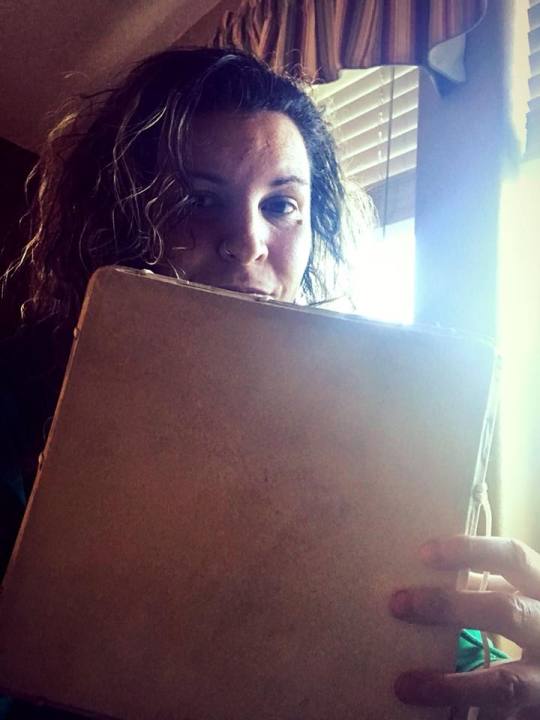
Some modern versions of the frame drum use a synthetic head, which is very good for learning. You get a good sound and an opportunity to build up some strength and toughness in your hands without obliterating your hands on goat hide. A rough goat hide drum will take the skin right off your hand if you are playing for hours and hours. So, either make sure you have a very smooth head or start with a synthetic head drum. I am very partial to the Remo Renaissance frame drum, 16" up to 18" for learning to make trance music. It has a lovely resonance that improves as the drum ages.
If you want to make ecstatic trance music, that's where things start getting more interesting. Most ecstatic traditions of the Med (perhaps all but I am saving room for anything I may have forgotten) involve making music using metal ringing against metal. This is because metal ringing against metal has been used to compel spirits in the Med since at least the Iron Age, if not before. Those associations run really deep to this day. So, any cult that has a focus on that sort of thing will have instruments built for it. Like these!
youtube
This is basically a cake pan. Like the kind you would have in your kitchen if you were inclined to bake. Percussion instruments have a very deep association with accessibility to the common person, the peasant classes, the public, the impoverished. Drums are meant to be smacked and you can do it to just about anything that makes a sound. They are not meant to be expensive or hard to play. So there are quite a few types of percussion instruments that have a whole other life in the kitchen apart from making music.
I am a firm supporter of the cake pan/cooking pot drum revival, especially in ritual context with the Mountain Mothers (like Kybele, Ida, Rhea, Magna Mater, & the Black Madonnas). Other instruments that are devoted specifically to the Mountain Mothers, apart from basic frame drums, include tambourines, tammorras, tribballacce, metal cymbals, sistrum, and pretty much any drum made with some kind of metal that rings against itself.
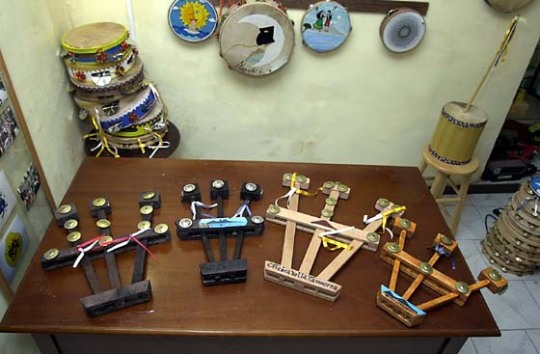
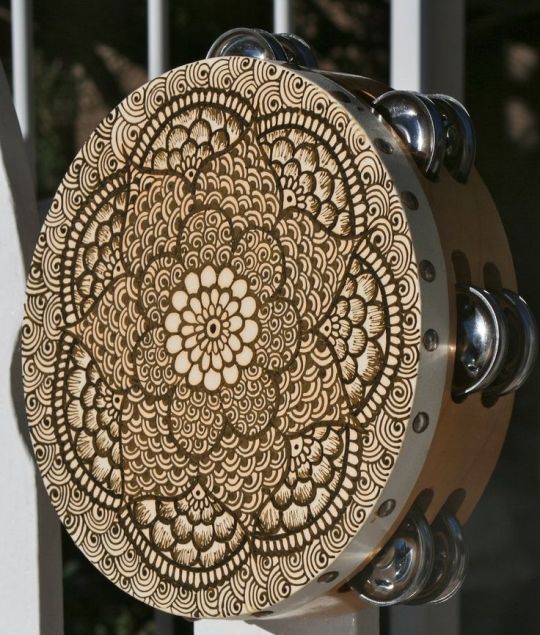

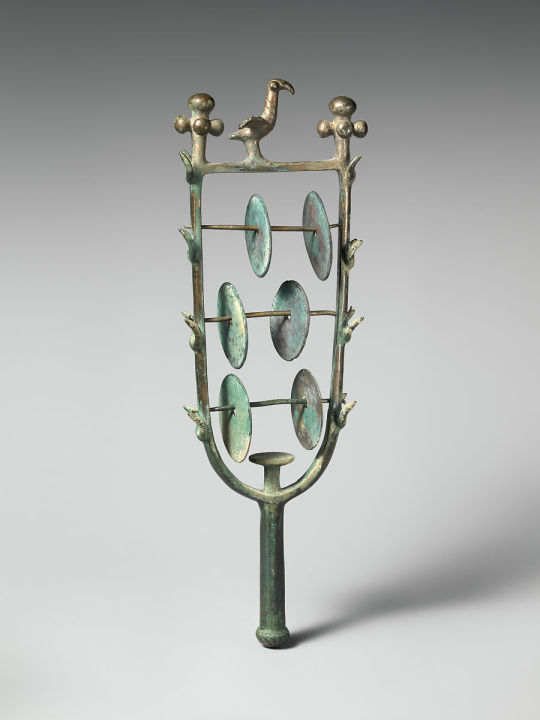
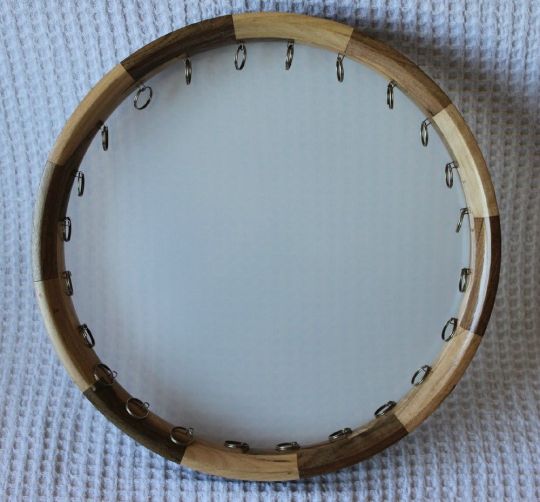
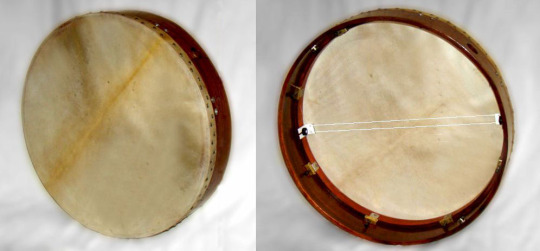
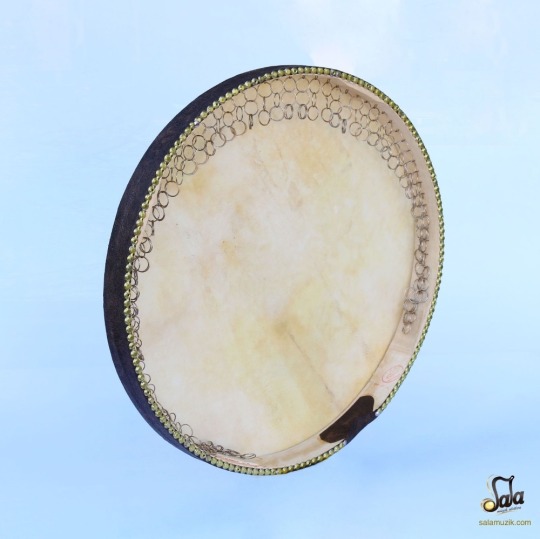
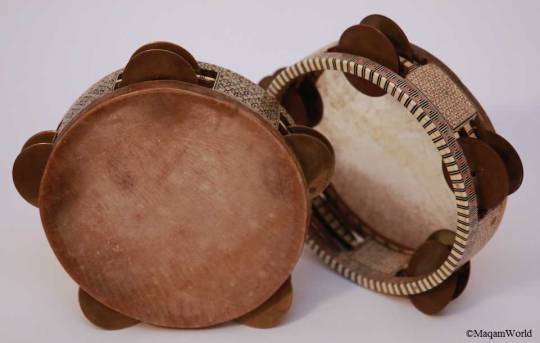
(Pictured: Tribballacce, Tambourine with a hennaed head, metal finger cymbals, a sistrum, Azeri Dayereh, Maghrebi Bendir, Persian Daf, & Egyptian Riqq)
These are all specifically used for compelling spirits, which is something the Cult(s) of the Mountain Mothers are devoted to. And this is something that the Dionysian cults adopted directly from the Cults of the Mountain Mothers. The Mediterranean style of play is what I call single handed frame drum--for lack of a better description. This is a style that is still prevalent among many of the Mediterranean islands and in what is now Southern Italy but it used to be a method used by pretty much everybody in the region.


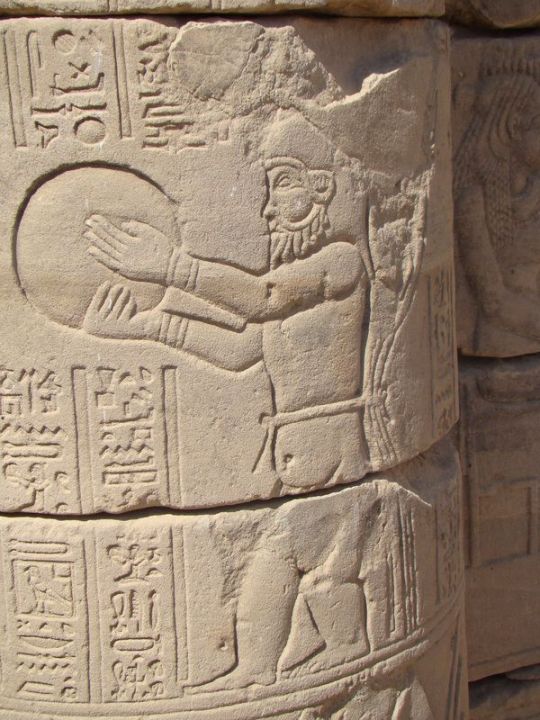
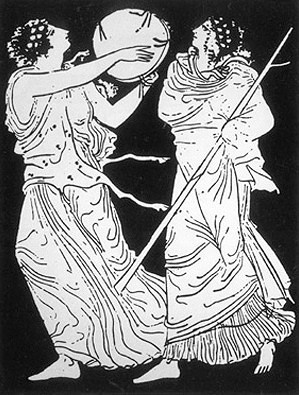

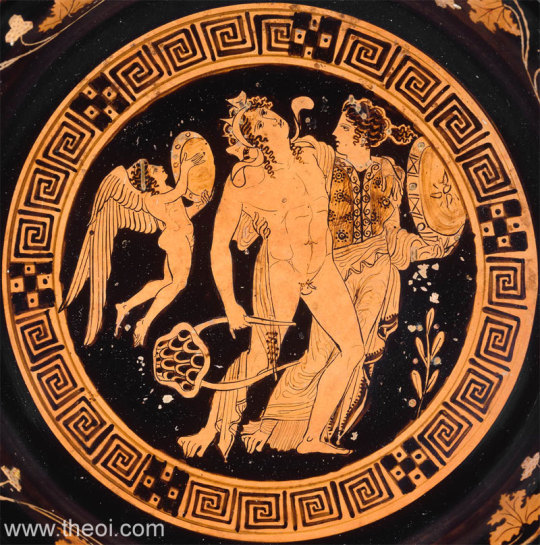
Okay, I lied. There is one lyre in this post. lol ^
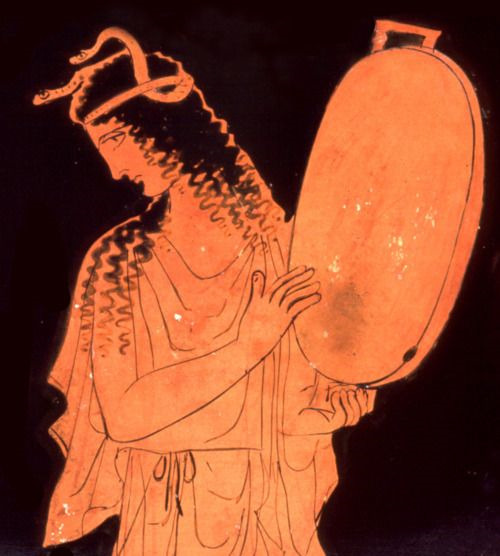
How do you play with one hand? So glad that I imagined you asking! There are a few ways. I started out by studying Southern Italian tammorra and tarantella rhythms but you can start anywhere you find single handed frame drum.
youtube
Now Dionysian trancework does everything and goes everywhere. Some variation of the Cult of Dionysos utilizes every possible avenue of trance. And sometimes so do the Mountain Mothers. I would say Dionysian trancework is an even split between metal and wood/hide percussion while the Mountain Mothers are more strongly associated with ringing metal--especially iron or bronze.
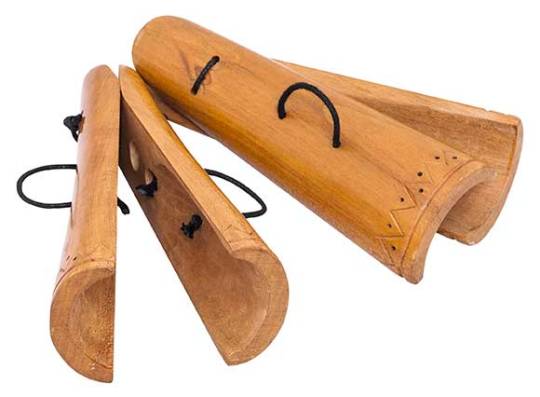

And that is where instruments like this come into play. These are classical Hellenic krotala. There are also even older Egyptian versions made of bone or ivory but the Hellenic version is largely made of wood. More modern options may include large nutshells as well. I did a whole two part deep dive on the Krotala. These instruments are found heavily in the Cults of Artemis & Dionysos but the Mountain Mothers do also occasionally get in on the action with these.
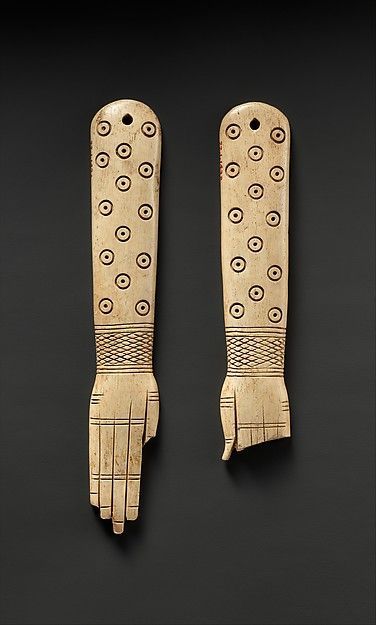
The Egyptian version, dated to about 1900BCE. ^
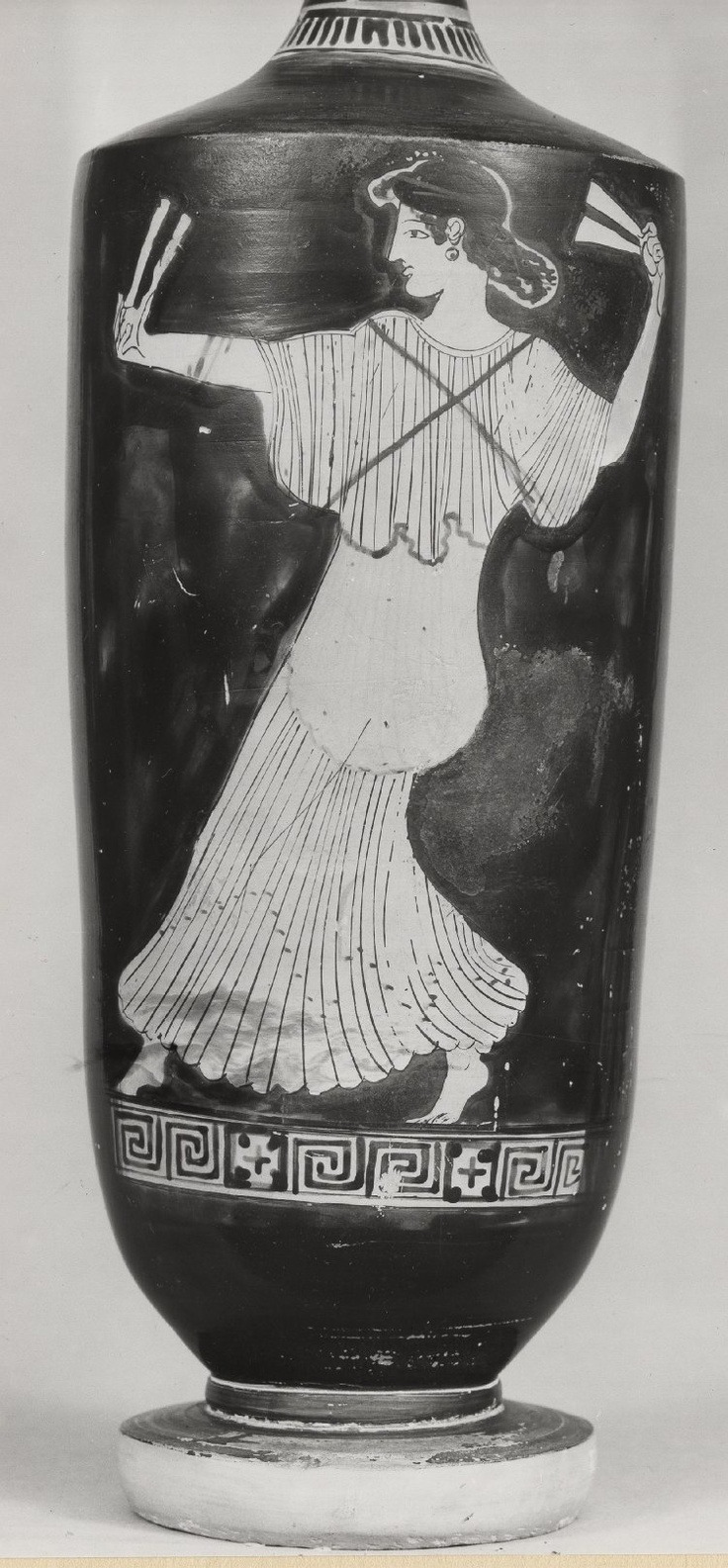


Classical Krotala in context. ^
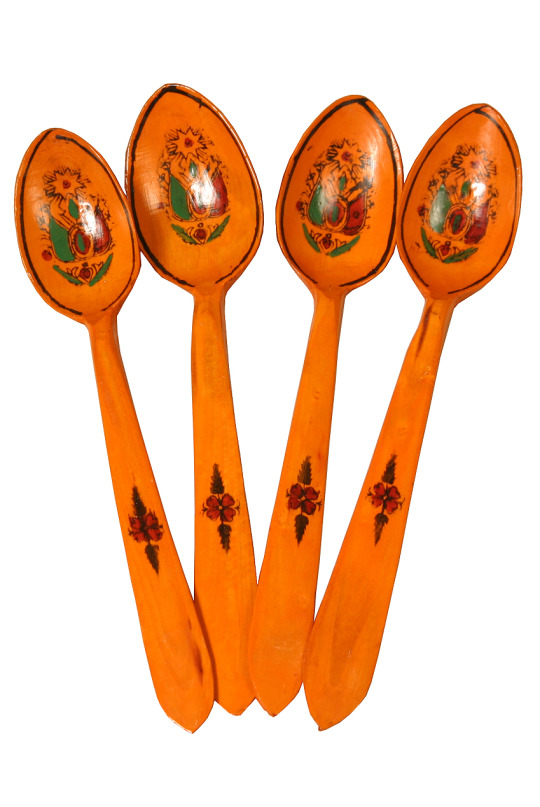
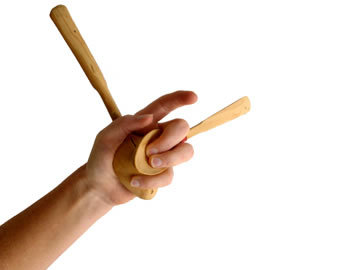
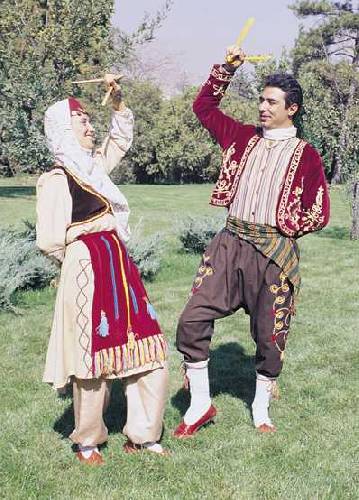
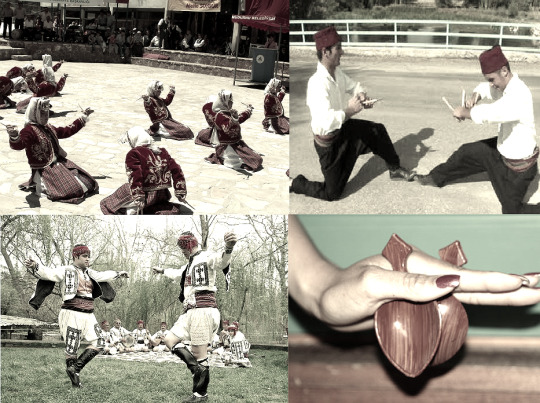
You can still find the dances that go with these traditions out in the world today. The Turkish and Hellenic/Turkish variations use wooden spoons (Kaşık or Kesik). And here's how you get down with these things.
youtube
There is also a Southern Italian version in the same family tree. This is Tammurriata.
youtube
And honestly more variations all over the place that I will have to get into in the 3rd Krotala dive installment. Tammurriata uses naccere, which are basically another name for castanets.
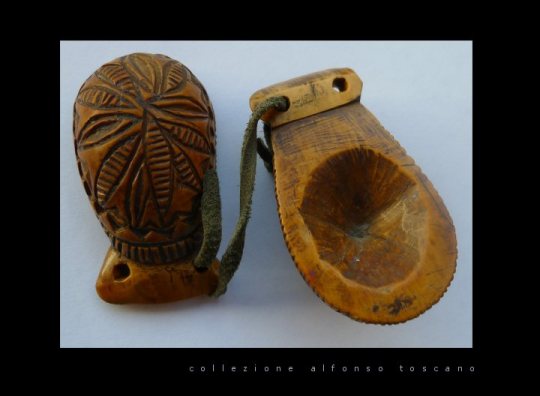
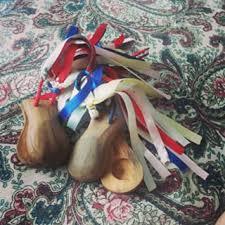
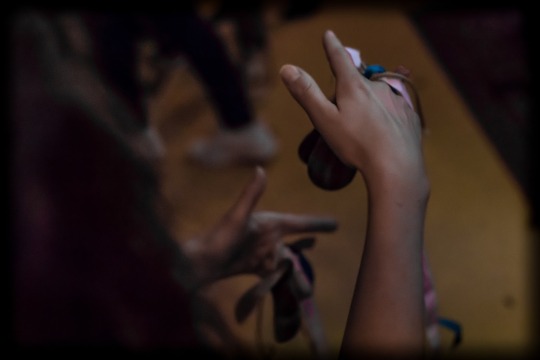
Now you might be wondering why we use different types of percussion for different things. The reason for that is compartmentalization and the inherent spiritual authority of the instrument. Wooden instruments are associated with wilderness deities and are valued at least in some part for their potential to burn. This makes them suitable for gods that double as both wilderness and death deities. Death because of the association with burning on a funeral pyre and special folkloric relationship between the dead and fire. Metals are not used in the same way.
Metals are associated foremost with the mountains where ore was pulled from. This gives them associations with darkness, caves & caverns, as well as monsters that go bump in the night. Secondarily, later in the timeline, metals took on an association with weather-based sorcery--which translates as Wind Spirits and Storm Gods as well as gods and spirits associated with Blacksmithing. So the cult of any deity who rules over caves, the sky, or weather spirits will use metal instruments in their rituals. This encompasses both the Cults of the Mountain Mothers as well as the Cults of the Storm Lords--and all their attending deities. This is where the practices of the Kouretes & Koryvantes come from.
And I will have to pick this up again in part II because I have reached my maximum allotted number of images for this post. Whee!
#trance work#hellenic polytheism#spiritwork#dance ethnology#cults#dionysos#kybele#zeus worship#artemis#Youtube
87 notes
·
View notes
Text
Monolith Do Not Exist
Let’s be honest, this sentence is one of the very few that sounds so much better in French, but I’m not here to discuss translation and adaptation issues.
What bugs me the most when I read worldbuilding posts is the impression everything is a monolith. Like you read the description of a country (sometimes a continent), and they have one architecture style, one type of traditional clothes, one religion and one language, even though communication is stuck in Middle Ages.
Then I look at France, my home country, and, even today, you can see many differences from one place to another. Just look at architecture. In the North many buildings are built with red bricks, giving them a very distinct color. In Normandy, Slates are used for rooftops and traditional building are one floor high (very low!), while on the coastline of this region you can see very distinctive English influences. Then Paris has this typical style called Haussmanian (6-7 floors, slate rooftop, white stone).
And the same goes on for everything else: religion (50% Christians, 40% atheists, 5% Islam), each region has its traditional clothes (though you’ll only see them in special events now), and as for languages, though French is the official language and most dialects are poorly treated by the elites and the government, some are still very much alive (Brezhoneg, Euskera, Chtimi come to mind).
So, if your world has more than one religion, consider there will be some minorities of other religions present in that country, even if your State has an official, aka State religion (France was Catholic for a long time). Immigration (forced or not) will bring new faiths in a country, trade too. Note, some minor faiths may be persecuted or discriminated against (consider the history of Jewish people).
Architecture was built with whatever materials were available in the area, because transport of heavy stones was too costly. Only the king and very rich people could afford to import other materials (in France, marble came from the southern mountain ranges, the Pyrenees and the Alps).
Traditional clothes would be made in the main materials of the area (from plants or animals), and you should also consider if people can or can’t dye them. Many traditional clothes in France have mainly black and white, with some touch of other colors... which might also be because most of these clothes were worn for mass, when people tried to look their best, but still modest in a way. Let’s note, certain dye were only available in some places (Florence had a famous blue), or legally restrained to specific social status (in Korea, gold and silver could only be worn by the royal family, bright colors were for the upper class, and the rest of the population was reduced to gray, white, brown and pale green).
Language should have variations (huge and small) unless you have modern communication or a schooling system where all children are taught a common language (it can still be their secondary language, btw). And while modern countries generally have one (sometime more) administrative language, it should be noted it hasn’t always been the case.
I don’t really have a conclusion, except please consider adding some variation in your worldbuilding, especially if you’re aiming for realism. By this, I don’t mean make detailed notes of every variation of every little thing, but even having a mention in passing can help a reader’s immersion in your story.
32 notes
·
View notes
Note
Happy Worldbuilding Wednesday! Do your characters have any particularly interesting fashion choices? What are they and why?👔🥻👘👗👚🛍
HOW DID I MISS THIS??? I'd wait to answer this tomorrow to be another Worldbuilding Wednesday, but I don't want to! Thank you for the ask! For this one, I'm choosing to go with my Crown of Blood WIP, since it's one of the few that I actually have kind of a plan for AND isn't just IRL casual clothes, lol.
For Crown of Blood, it widely varies by region, as well as social class, but most if it is medieval era Western (and East Asian!) clothing. I don't really know how to explain the fusion quite yet, but basically for Adrasteia specifically, she has a wider range because she's literally royalty and can therefore afford import costs. Her outfits range widely from more standard traditional clothes to clothes that have a fusion in terms of cuts and patterns. Skirts that wrap and tie, but are shaped kind of western, etc. Think some of the fancier clothing in Meiji period Japan as well as the mutual Eastern influences on Edwardian England and France.
There's an article about it on "lilyabsinthe.com", and while I don't know the validity or full accuracy of these claims, either way I liked the idea and want to explore it more. I've seen more modern examples of ideas online, of people mixing traditional and kinda modern pieces that I like, but I unfortunately don't have any on hand (it is VERY messy in my phone lol). But I'll leave it here because it's getting WAY too long haha.
The commoners/less obscenely wealthy, I'm thinking of a few ideas for. I initially was curious about the idea of clothing similar to some minority subgroups (I was particularly fascinated with Ainu and Nivkh clothing), but then I realized that might come across as insensitive/sending a bad message, etc. So I think I'll leave that for another story. My current idea is to have either medieval western clothing or even older East Asian clothes, though I haven't 100% decided which one is better/simpler etc. I'll have to determine the weather first. Obviously since this is an empire, there are definitely other cultures and societies that all make up the bigger entity. So they're not going to all have the same clothes, even amongst commoners if they're from different regions.
I think I'll have to determine the weather/terrain and culture of the regions first. The main hub of the empire is kinda woodsy with various bodies of water (but no ocean), so they might traditionally opt for tighter fit clothing- but I mean, Europe had plenty of forests, and people still wore long skirts, so... maybe I'm just trying too hard!
This is DEFINITELY too long now so I'll cut it here! Basically I've no clue yet, but I'm really fascinated by the idea of a fusion! Thanks again for the ask!
7 notes
·
View notes
Note
ong hiiiiiiii do u have a first name u use for quint?? :3 love getting to hear ppls thoughts on The Guy
Okay okay okay I have been Ruminating on this ask because I realized I genuinely don't have a first name for him. To me he is Quint. Like he is sooo fundamentally Quint to be. Quint Quintleston, if you will, but also I think some of the commonly accepted names like Bartholomew and Sam are pretty neat.
But.
Butttt I don't think they're RIGHT y'know?? It's hard to explain, but I have this very specific idea of how Quint grew up in New England that those names just feel Wrong. Bartholomew is a bit too British, and Sam is a bit too uninspired (sorry Sam enjoyers that was the only way I could describe my thoughts about it).
He grew up along the coast of Massachusetts, obviously, I can't imagine him growing up anywhere else, and was one of the older (but not oldest) siblings of his family. From my experience, New Englanders hate weird names. Not explicitly, but they always veer to the realm of safety and pick whatever's at the top of the list in 'most popular baby names.' That's just how it is-- the region is very traditional and conservative (not necessarily politically, but morally). So I would not be surprised if Quint had a very very boring and common name.
If we're going off Quint being the same age as Robert Shaw when he appeared in the film, then let's say he was born in '35, so the most popular names then (at least according to Wikipedia I didn't feel like looking at actual statistics) was James, Robert, John, Thomas, Donald, etc. I don't think he has those names specifically, but I think he had one that is SIMILAR to those names. A la ye olde blandness style. Obviously that list doesn't account for geographic location but oh well.
But this is the thing with New Englanders, specifically ones who are lower class: they will typically resort to these names because they are Biblical, and while not as religious as some other regions in the U.S., rural New England tends to be very Christian, and you’ll encounter more churches than actual people. I sort of believe Quint grew up in a semi-religious household. Not outlandishly so, but what I call “New England Christian levels,” where you say grace before dinner and go to church on Sundays. Definitely think he’s estranged from his family now and non-practicing, but now I’m getting off topic.
I think we've also got to consider coastal regions and families of fishermen and sailors and the idea of passing names on generationally from father to son, and my GOD do you get some cool names. Some regionally famous captains from where I'm from have some of my favorite first names, Ephraim, Reuben, Lewis, etc. I imagine Quint's family being involved in coastal work as an inherited job throughout the family, so it would make sense if they retained some of these naming conventions. I wouldn’t be surprised if Quint was named after a sea-faring forefather as part of carrying on the family name, and because I think he’s estranged from his family, it would make sense in the movie why he’s never referred to as anything other than Quint: he’s rejecting an aspect of his family and embracing a kind of ‘new identity’ for himself. Out of personal bias, I kind of vibe with this option more so because I grew up in a coastal fishing community and think some of the family names are cool as shit, but that's just me.
So there's kind of two alternatives for what Quint's first name COULD be in my mind: boring boring bland typical New England, or Olde Traditional Captain
Also I should say because Tumblr reading comprehension is so ass: when I say 'New England does x' "New England is y' I AM SPEAKING FROM PPERRSONALLLL EXPERIENCEEEEE (as in, I AM A LOW CLASS NEW ENGLANDER LEAVE ME ALONE) different areas within the region are VERY different from one another. Like I could talk about the coastal vs northern social differences for so long and that's just for the state where I live
#i have sooo many thoughts about quints history do not get me started#just apparently not enough about his name#if you read this whole thing? sorry!#quint#captain quint#jaws 1975
20 notes
·
View notes
Note
pspspsops
hi 👀
i havent decided yet what culture i want the genie dca to come from but if you would like to infodump about arabian or persian clothing (both royal and commoner wear) i am all ears
hmmmm
Okay, I don't really know too much abt clothing (unfortunately not much of a historical expert), but here's what I can tell you:
as said before, clothing typically depends on the region and the culture/ religon of the place, as well as the place in society
So, as said before, higher class is gonna wear brighter colors (ex: purples, greens, blues, bright yellows) with complex designs, while commoners wear duller colors (browns, creams, whites, some dull greens or yellows, a few blues) with more plain fabrics
I think I mentioned fabric type earlier, but here it is again: silks and satin were reserved for the more wealthy, while commoners typically just stuck to cotton
Richer people wore LOTS of jewelry. Gold chains with patterns of stones, large necklaces with jewels hanging off of them, bracelets that jingle with every movement...style depends on the place. A lot of places like to incorporate eyes into jewelry and decor, so that's a place to start. Simple bead bracelets can have engravings with arabic text. Beads can be huge or small and simple. Kohl ( an eyeliner) is pretty popular, as is henna in a a lot of places. Henna art can usually be done on the hands and arms.
If you're trying to find a country to base it in, I'd recommend doing your own additional research in case. I'd suggest going with somewhere further out from the heart of the Middle East. So think more northwest: Turkey or Syria or maybe Iran (Persia in the olden days), as opposed to Saudi Arabia or Iraq or Egypt. Based on your genie design, I'd assume it'd probably be largely influenced by Indian culture, though you'd have to ask someone more knowledgeable about that. So maybe around or closer to those regions?
If you're wondering about hijabs and veils, not everyone necessarily wore a hijab, though it really depends on the era. If you're asking for religious sides, Islam claims that hijabs were a must from the beginning. History (which I've found some Islamic scholars do in fact agree with on this) says that hijab was actually later introduced as a cultural thing, and started out more as, again, an upper class thing. Women of high standing wore thin veils of silk and satin. This was around 62o-630 CE, I'd say, though, again, I'm not too sure.
Main language would probably be Arabic, although really it was a mix. To be on the safer side, you should probably just stick to English, cuz even among Arabs we struggle to figure out what different people are saying. The language depends on the region and dialect (Ex: people from Egypt and Lebanon are said to be softer with their pronunciation of things, while Iraqis and Kuwaitis are a bit rougher with pronunciation). A single word can have multiple meanings depending on the place you're at, and some dialects have words that technically don't even exist. (Ex: Iraqis refer to tissues as specifically 'Kleenex' because that's the most well known company. Then again, this could just be among my extended relatives, so take this with a grain of salt.)
In terms of clothing styles and choices:
For women, it's gonna be a biiit more modest in some regions as opposed to others. Some places refuse to show a singular inch of skin, while others are pretty lenient. It again, really depends on where you're at. If you're not exactly sure where you wanna place it and want to do what the movie did and make up a place, I'd suggest covering up most stuff, arms, legs, shoulders, etc. Pants and dresses are pretty much interchangeable.
For men...I wouldn't really know, actually. Modern day they don't really care and tend to just wear the typical t-shirts and jeans in some parts, or something a bit more traditional. I guess it was pretty long robe, if you want to think of it like that? They covered up, too, though for a different reason (prob the heat).
If you want to add in a Jasmine, I could give you a small bit of info on rights of the time. Women could hold positions in financing (it is pretty well known that the first wife of Muhammad [Islamic prophet] was a businesswoman and a merchant herself), as well as own and sell property. I'm not too sure if they could hold high positions in government in some places, though in others there were females who did go into battle or become sultanas. In history it is known that many people were ashamed to have daughters and sometimes buried them alive, though this supposedly changed after Islam was spread (whether or not this is true I'm not sure). Slaves were still a thing and continued to be a thing, although during the khalifa it was said that you couldn't enslave a Muslim. Most people don't believe this to be true and say that slavery was completely wiped out after the introduction of Islam, so I'd just be careful about this topic because it kinda depends on who you ask.
In terms of clothing patterns, vines and flowers were pretty popular, as well as this one textile thing I dunno how to describe...if you've seen Persian rugs than it looks similar to those. It's very geometric based, too. Here's a picture to get the idea tho:
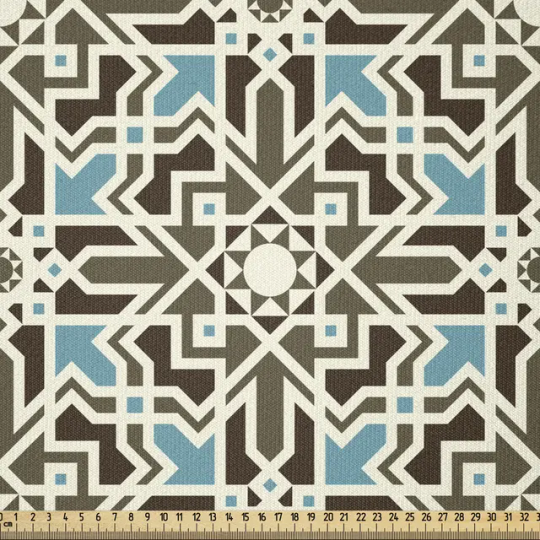

....Okay just look up Persian rug and you'll get the idea, I dunno how else to explain it.
Sorry if this wasn't very helpful, I kinda had to rush it cuz I have a lot of stuff to catch up on. Hope this did something, tho!
#asks#i info dumped randomly there sorry#hope this helped a lil!#sorry if it didn't#I'm on a bit of a time crunch rn#a lot of assignments are calling my name
8 notes
·
View notes
Photo

Pichu, Pikachu, and Raichu top normal bottom shiny.
How to evolve: Pichu to Pikachu friendship, Pikachu to Raichu Thunderstone.
Region: A region of eternal night as scientists created plants that could grow in moonlight, though there is some places that try to create artificial lights for the plants that couldn't grow in the moonlight. The moon still changing to different fullness percents with times there is no moon visible.
Region name: Lunar region.
Type: Electric fighting.
Ability: Pichu: Static. Pikachu: Lightningrod. Raichu: Scrappy.
Description: These pokemon are the most popular among those who truly enjoy martial arts. They can use their electricity to power their muscles (Thanks to https://www.tumblr.com/dragonsrule18 for helping with that idea.) in order to more strongly attack. They are well beloved by anyone interested in the martial arts scene, including anyone who is just a fan of any martial arts sports. They are even the mascots of various martial arts spots as all three evolutions are even presented before martial arts sports begin. It has basically become a tradition to do so. Even though martial arts fights are usually between two people these pokemon get heavily featured in the events. They are even known to have plenty of merchandise. Most martial arts clothing is inspired by this evolution line with beginners wearing clothes inspired by pichu, those in the middle ranks wearing clothes inspired by pikachu and those at the higher rank wearing clothes inspired by raichu.
Pichu is the weaker of the line and can only slightly boost itself with its sparky electricity. It doesn’t have many electric attacks as its electricity in its body is still developing, thus mainly using other moves to make up for it. This pokemon is the one that has merchandise often directed more to children than adults. It is truly seen as the baby fighter thus is used to represent the beginners in martial arts. This pokemon is known to try to act tough especially around any of its evolutions, though out of the three tends to be more of the lap pokemon compared to the other two. It loves to cuddle though also tries to involve its trainer in any training it partakes in. Despite loving to cuddle this pokemon will let that go to train beside its trainer. It is sometimes used by beginner martial arts classes to motivate the students into the training they are doing. While this pokemon does try to train it is known to fall down at first until it can get a move just right, making it perfect to lighten the mood of a training session especially on new moves.
Pikachu is more outgoing and tends to use its cute looks to get its way at times. Its skills are more developed compared to it’s Pichu stage. With it able to use more electric moves than before. It loves martial arts to the point that it will even watch martial events alongside its trainer much like someone very interested in it would. It is often seen having its own viewing platforms above the ring at martial arts events where it can watch in its own VIP spot. Any Pikachu is free to go there and usually the first one up there is the one used before the martial arts matches. This pokemon will even go down to stand by the winner of the martial arts event thus many pictures of winners surrounded by Pikachus is very common. These pokemon if raised from a Pichu will love their trainer very much and be super loyal to them. One infamous story is about how a newly evolved Pikachu chased off an intruder, who meant harm to the residents, to the home of its trainer beating the intruder so bad that police were able to easily identify the intruder; all while the trainer slept unaware of what was going on until waking up to the intruders screams. That Pikachu was given a medal for heroes of the region and the trainer was given plenty of gifts for that Pikachu, basally becoming a celerity overnight. This pokemon also uses its ability to collect more electricity to boost its muscles further to attack harder.
Raichu has plenty of electricity stored to boost its muscles to attack. This pokemon can learn more of the fighting type moves compared to the other two before it. The tail wrapped around its body is used to help regulate the high amount of electricity in its body. The tail tip can release electricity into the air if there is too much in its body, while the rest of the tail helps the flow of electricity through its body. This pokemon will unravel its tail from its body in order to use as a last resort type attack usually if someone or something attacks it to the point of it needing to do so to escape. Its tail can be used like a blade moved at high speeds in order to strike out at an opponent. Thus it is usually not recommended to touch this pokemons tail since it will either cut you, if touched on the edge of the tail, or it will shock you from the electricity it helps to regulate. Despite the potential in this pokemon’s tail it prefers to use its hands and feet to attack rather than use its tail. It is believed that this is because this pokemon’s tail is actually sensitive as most are even sensitive about the tip of their tail being touched even by its trainer. Though it is only a theory as no real explanation for it not liking its tail to be touched has been discovered. Some trainers think that it could be just trying to protect others from the danger that its tail has, though again it is only a theory. Its strength and being one of the best in fighting attacks tends to be the reason it is seen with those close to martial arts masters. This pokemon is seen as representing mastering a martial art. In some martial arts classes it is even tradition to gift a student who owns a Pikachu a thunderstone, only when that student masters their martial art. Which this student will offer their Pikachu the chance to evolve though it cannot be forced on the Pikachu. The trainer must accept if their Pikachu doesn’t wish to evolve yet. This pokemon is actually highly protected by the martial arts groups, and anyone who owns one tends to be seen as either an ultimate fan who got lucky, or a potential martial arts master. If this pokemon is owned by anyone who does something that is seen as bad or evil then this pokemon will receive no blame as its seen as being forced into the act, while the person is judged very harshly to the point that if a martial arts person sees that person that did the act then they are challenged to a duel or chased away from even cities.
Lore:
Pichu was rumored to be discovered by the man who created the first version of martial arts. It is said to have worked with the man as the man grew from a kid to a teenager, helping encourage him in developing the martial arts moves. It was even said to have been doodled in the notebook owned by the one who created the first martial arts. Its time helping that man with the early years of developing the martial art at a young age helped lead it to be seen as great for representing beginners to martial arts. Eggs of these pokemon were allegedly gifted to those that were the first to master the mans martial art training, even though by then the man had aged many years and his Pichu had become fully evolved. Some parents will even spend lots of money to get their child one even as an egg if the child shows high interest or talent in martial arts. While it is seen as a representation of beginners it is still used in showings before martial arts events, due to most in martial arts believing that beginners are just as valuable to the sports as those who have mastered it; as well as being the one to represent the beginning of martial arts itself due to its history with the man who created the sport.
Pikachu’s love for martial arts is believed to have been born from being raised by the man who created the first martial art. This trait having been rumored to be passed through the generations until every single Pikachu has this trait. It is strengthened by the fact that it is usually raised by those who love martial arts or are learning martial arts themselves. It however tends to be very popular among the biggest fans of martial arts more so than those who do martial arts. As more fans own Pikachus than those in the martial arts, though lots of those practicing martial arts do own Pikachus of their own. It is still beloved by those in martial arts and the fans have began to even believe that its inclusion is to represent them. It’s love for martial arts is said by fans to represent their love for the support, and that the winner pictures with the Pikachus surrounding the winner is meant to represent the winner being surrounded by fans of the sport. Big fans who own Pikachus tend to spoil this pokemon due to its huge prescence in the sport they love so much. Most fanbases for the sports prefer to use a Pikachu as their logo or mascot. While Pikachu is beloved by those in martial arts its popularity with big fans can sometimes be seen as problematic. Since those in martial arts want Pikachu to be representative of those still learning but aren’t beginners, as well as that the one owned by the creator of martial arts evolved as soon as the man was becoming better at the craft thus representing the creators passion for what he was creating, instead of being a representation of the fans of the sport. Though big fans are not looked down upon for owning a Pikachu as long as it is well taken care of. This pokemon is actually believed to be one of the most spoiled pokemon in the entire region, outside of the royal Eevee’s of course though no pokemon can compare to Eevee and its evolutions in this region.
Raichu is held in the highest regard in the martial arts community. This pokemon is even rumored to have evolved itself for the martial arts creator when he had completed the creation and mastery of the sport, using his own collected Thunderstone in order to evolve on its own accord. If a trainer is able to use a Raichu it is seen as a high achievement for that trainer. While mostly used by those who have mastered martial arts there have been trainers who have been able to use one to harness their strength in Pokemon battles. This pokemons most famous logo is that of an elite martial school. It is seen as the representation of the masters of martial arts and will even be seen welcoming martial artists to the ring when each martial artist is introduced. Since it is seen as a martial arts master and legend welcoming each fighter to the stage. Not much else is usually documented about this pokemon beyond its status as a representation of mastering martial arts.
Design inspiration: Teenage Mutant Ninja Turtles, martial arts in general, martial arts outfits, Pikachu being a popular icon of Pokemon hence all the love looks on Pikachu, Pikachu being seen as adorable, and the spiky eared Pichu.
Lunar region is a region that I have thought about making. I will be making more Pokémon and variants for this region.
#pokemon#pokemon region#pokemon regional variant#pokemon regional#pokemon pikachu#pokemon pichu#pokemon raichu#pokemon regional pichu#pokemon regional pikachu#pokemon regional raichu#pokemon regional form#Pokemon Lunar#pokemon lunar region
4 notes
·
View notes
Text
[FMP] Research into Tasseography - Different Countries and Regions that practiced Tasseography
Tasseography, or reading tea leaves, has been practiced in many countries, including China, India, Turkey, Europe and the Middle East.

Origins - China
Tea leaf reading is a tradition that likely began soon after the discovery of tea by Chinese Emperor Shen Nun in 2737 BC. where tea leaves were first used as a form of divination by wise sages.
One origin story suggests that after sharing a pot of tea, a group of friends discussed their affairs (just like we do today) Then, someone realized and pointed out that the tea leaves in their cups contained symbols reflecting the topics of their conversation.
Over time, the practice spread along the historic Silk Road, reaching various parts of the world and adopting cultural nuances along the way.
In the Middle East, for instance, coffee grounds were used instead of tea leaves, giving rise to a similar practice known as "tasseomancy."
Coffee-reading - Turkey
This is traditionally practiced using Arabic or Turkish coffee, as they produce very thick sediment. The coffee in the cup is consumed, and the sediment is left to settle.
The common methods require the cup to be covered with the saucer and turned upside-down.
In the Turkish tradition, coffee readers often interpret the cup as being divided into horizontal halves: symbols appearing on the bottom half are interpreted as messages regarding the past, and symbols on the top half are messages regarding the future.
The cup may also be interpreted in vertical halves to determine "yes" or "no" answers as well as the overall outcome of the events represented by symbols. For example, some fortune tellers may "read" symbols in the "left" half as "negative" events or outcomes, while symbols in the "right" half are "read" as "positive".
Other readers may adhere to the belief that the cup is capable of revealing insights about the past, but it cannot predict events beyond forty days into the future. The saucer may also be incorporated into the reading.
Especially women like to tell their stories and tell fortunes because of their curiosity about the future. It is believed that fortune-telling gives information on issues such as love, success, work and health.
As with the cup, different variations exist for what the saucer represents, including whether the saucer sticking to the cup indicates a "positive" or "negative" outcome.
However, thanks to the Scottish botanist Robert Fortune (1812-1880,) other countries were able to easily reap the healthy benefits of tea and analyze the patterns left behind. Fortune smuggled tea plants to Scotland, which allowed even the lower classes to indulge in this regularly.


Throughout history, people have turned to these divination methods to seek guidance, wisdom, and solace in times of uncertainty.
0 notes
Text
Birmingham: An Oasis of Innovation and Growth!

Birmingham is not just any city, but the town in the West Midlands region of England that is a source of history and high-tech interest to the scientific traveller! Imagine this: a dynamic city alive with passion, dedicated educational hubs that bring students from all over the world to inspire one another, and exchange their ideas, traditions, and findings. It is indeed unchallengeable for other international students to start their learning and discovery journeys from such a centre. But perhaps more importantly, it is time to talk about student accommodation – from student apartments to airy student common areas in Birmingham, there is something for every scholarly type. This city does not simply propose accommodations; it offers a place for future prodigies to grow and develop while engaging with objects from the industrial age to today's city's most recent inventive solutions.
What makes Birmingham ideal for international students?
Cultural Fusion: A Melting Pot of Ideas
It should be noted that Birmingham itself is home to an outrageously multicultural population. It’s like living in a world fair since there are over 180 different nationalities among those residents. To an international student especially, this means exposure to international foods, ways of talking and even thinking. Where else can you talk about engineering with a Japanese student and balti curry which is a Birmingham specialty? It looks like two cool worlds are coming together here: check out that cultural rapport!
World-Class Academia
This city is hub to some of the finest institutions from the University of Birmingham to Aston University and more. Whether you are to dive into a more rigorous area of quantum physics or break down the AI algorithms, Birmingham institutions give you the implements. Science is not merely vibrant here but is ALIVE!!
Affordable (and Student-Centric) Living
Frankly speaking, any college budget itself, can be compared to the density of diamond molecules. Good news: Birmingham guarantees a high quality of life at an incredibly lower price than that of London. Student-friendly, variety of food options at a low price, and is surrounded by good railway and bus connections (West Midlands Metro).
Tech and Innovation Hub
If you love science and technology then Birmingham is the place for you. The city is currently quickly growing into a technology hub with thousands of start-ups, and various industries. Feeling the need to make what you have learned in your classes come to life? Here, you can.
Green Spaces and History
Most people want a time when no equations are solved and no boundaries are crossed. That is exactly what Birmingham’s parks, including Cannon Hill Park, do. Adding to that, the city is rich in industrial history and has canals to top it off. You truly get immersed in a living book of Engineering wonders of the world.
Access for the Rest of the UK
Birmingham itself is right in the heart of England, so it is very easy to travel to other cities. Downing Street Piccadilly Circus, or Salford’s MediaCityUK? No problem. Well, at least it moves in some way, it is like combines the technology of teleportation, but less effective.
Quality Student Housing in Birmingham
Aside from academic offerings and patrons’ living styles, it is the quality of student housing that plays the most part in enhancing a college experience. Through availing of such platforms as the Student Tenant, the process of searching for the right student rooms in Birmingham is made easier, and tailored. If you are aiming for a personal studio or else, you prefer an open creative hub that fosters interaction with other creative freelancers, Birmingham has got you covered. It’s not just about finding accommodation – it’s about establishing an environment to support academic success in a city that combines the latest technologies with the atmosphere of the Middle Ages.
0 notes
Text
Subtext and Culture, Young Royals, Season 2, Episode 2
Episode 2 probably picks up the day after the first episode...

Subtext: ...and in the first shot of the episode, we see Malin literally stalking Wilhelm as he's making his way to classes. Of course, Malin has already been informed by the royal court that they're pulling Wilhelm, which is why she's keeping a close eye on him.
Subtext: since Wilhelm isn't answering his phone, the Queen called the principal, and is using her to get Wilhelm to talk to her. However, Wilhelm is completely uninterested, and distracted by a certain someone's singing coming from the music room. This directly mirrors how S1E3 started...
Subtext: ...but unlike those happy times, Wilhelm doesn't join Simon in the music room, he walks away, giving Simon space.
Culture: Different countries have different birthday songs, and the girls are of course singing the Swedish birthday song Ja må hon leva.
Culture: In Sweden, cheers are fourfold. Three cheers is something that the treacherous Danes do, and we of course have to be different. In some Denmark-adjacent regions of Sweden it's common to do a threefold cheer, which proves they're all Danish traitors.
Subtext: It's extremely uncommon in Sweden to have to re-take a year of school, which is why the other girls are so surprised that Sara isn't the same age as them. In Sara's case, it's because she was severely bullied at Marieberg and missed too much school.
Subtext: For the other girls, this is nothing, and even though they try to smooth it over, the implication is that Sara will have to pitch in an equal amount for each of their birthdays, and that is way beyond her means.
Culture: Simon is singing Cumpleaños Feliz, which is the most common birthday song in the Spanish-speaking world. It is a Spanish version of the well-known English birthday song Happy birthday to you.

Culture: Pabellón is a traditional Venezuelan dish, which means we can safely assume Linda is from there as well. This is of course a reference to Omar himself being from Venezuela.
Subtext: Sara is consistently denying her family and roots, and choosing her new, rich friends, which is why she'd rather spend her birthday at the Manor House than at home.
Subtext: Sara said she needed new riding pants way back in season 1, but her family couldn't get her new ones until a special occasion like her birthday. But of course the other girls can afford a much more expensive gift just like that, and Simon's disappointment is immediately visible.
Subtext: And to make matters worse, Sara is asking to exchange the lesser pair of pants for cash, because she thinks she needs money to keep up with her new friends.
Subtext: Then again, Rosh and Ayub are treating Sara like crap, giving her a quick grats before quickly moving on to gossiping about Marcus.
Subtext: A throwback to season 1 where Sara accuses Simon of always putting other people before himself, and since Marcus actually seems to have his shit together, Sara joins Team Rebound, pushing Simon to get over Wilhelm.
Cinematography: The colour of Simon's clothes signals how he's feeling. Purple means he's feeling close to Wilhelm, but yellow means he's feeling independent and like himself. In this scene he's wearing a purple shirt over a yellow sweater over a purple t-shirt. Make what you will of that mess.
Culture: It's PE class, and the kids are playing Innebandy, or Floorball. This sport is extremely common in the Nordics, and is often used as a stamina exercise, because it's a very simple team sport that doesn't require a lot of technique. Literally everyone in Sweden has played it at some point.

Subtext: Wilhelm ignores Simon and instead passes the ball to Walter, who fumbles and allows the other team to score, which is the show telling us that Wilhelm shouldn't ignore Simon because he'll lose that way.
Subtext: Isn't it funny that it's always the people at the top of a hierarchy who are the most insistent on the usefulness of that hierarchy for everyone else?
Subtext: Villain era Wilhelm is making more moves that will backfire spectacularly.
Subtext: Simon wants Sara to sit next to him so that Wilhelm has to sit somewhere else. Unfortunately for him, Sara has to sit with Felice.
Blink and you miss it: Wilhelm takes off his red sweater and hangs it on his chair.
Subtext: Some nice foreshadowing for the final scene of the season where Wilhelm does tell the truth for a change.
Subtext: The principal has of course already been informed that the Queen is pulling Wilhelm from Hillerska, which is why she's saying goodbye to a confused Wilhelm.
Blink and you miss it: Simon swipes Wilhelm's sweater while the teacher is busy taking Felice's phone.

Subtext: The frog prince snowglobe from season 1 makes a comeback! This object symbolises how trapped Wilhelm feels by his crown, his royal duty.
Subtext: August wants nothing more than Wilhelm to be gone from the school, so that he can stop sucking up to him, and restore the order and discipline that Vincent is whining about.
Subtext: Malin, no! How could you?! She's a police officer, she can legally manhandle Wilhelm, but though the optics aren't exactly good in this case.
Subtext: They struggle, but at the end the glass breaks, the prince is finally set free, and can kiss his... prince?
Culture: Swedish doesn't have generic words for grandparents. Instead, you have to specify exactly which one of your four grandparents you mean; mormor, morfar, farmor, or farfar. Erik says "morfar", which means the Queen's father, which means Erik got it from the previous King of Sweden.
Culture: Wilhelm and Erik are probably playing the game A Way Out by Swedish game designer Josef Fares. It's the same game Simon can be seen playing in S1E1, and it's a tragic co-op game that ends by one of the players killing the other player.
Subtext: Except Wilhelm's feelings for a boy is the very thing that threatens the monarchy. Him being truthful is the threat.
Cinematography: No, Jan-Olof has been called in by the show creators to be a villainous personification of The System, thus allowing the Queen to become more sympathetic and more of a mother to Wilhelm.

Subtext: Ok, so the now more sympathetic Queen says that they fully accept Wilhelm being non-straight...
Subtext: ...and then she immediately blows it by calling a same-sex relationship "unconventional". Yeah, no.
Subtext: The problem is that Simon has explicitly said that he does not accept the situation of Wilhelm's position, so this isn't helping. Also, that eye-roll is fantastic.
Culture: Sweden is 69% forest, so if you want to say "In the middle of nowhere" in Swedish, the expression is "mitt i skogen" - in the middle of the forest. In completely unrelated news, 17% of Sweden is covered by European Blueberry.
Subtext: August's stress levels went up quite a bit since he thought he was finally gonna get rid of Wilhelm, but he got to stay, so August runs back to his ADHD meds.
Culture: Finally the show reveals another house at Hillerska, Granhult - Sprucewood. At the real-world boarding school Lundsberg, one of the houses has the very similar-sounding name Gransäter. "-hult" is a common part of Swedish place names, and it simply means a small forest or woods, so the translation checks out.
Subtext: What August says applies directly to Wilhelm, he has to give it all he's got to get Simon back.
Subtext: Wilhelm negotiated and compromised with his mother, getting some independence and agency back. So now he's trying to negotiate with Simon, offering a compromise to him. Unfortunately, it's not enough.

Subtext: Simon says he wants to stop ignoring Wilhelm, they have to be able to talk about the things they do together as friends. So this is where Wilhelm realizes rowing is one way he can stay close to Simon.
Subtext: Just like Rosh and Ayub interrupted Sara's celebration with more Wilhelm/Simon drama, Felice is doing the same here. At least Stella calls her out on it.
Subtext: Of course Stella challenges the intense heteronormativity of this game, while Fredrika is completely oblivious.
Culture: Tjejsnack literally means Girl Talk, and was a game that was sold in Sweden in the early 90's. It's a product of its time to put it nicely, and it's basically Truth or Dare made into a winnable board game. The original manual to the game says it's a game for girls ages 8 and up. Yikes.
Subtext: No, this is not how the game works, only the current player has to do a truth or dare, but Stella is just pretending everyone has to tell the truth so she can get the deetz on the others.
Subtext: Felice lies about how many people she has slept with in order to appear more proper and less promiscuous.
Subtext: Sara needs all the help she can get to figure out interpersonal relationships and sex and romance. Unfortunately, this is pretty shit advice, because just because you lust after someone, it doesn't mean they're a good person or that it's a good idea to have sex with them. You should probably apply a few more criteria before making that decision.
Lost in translation: The subtitles just cover the highlights of Felice and Wilhelm's text conversation, but it's rather long, so I put it all in a separate post: https://www.tumblr.com/skamenglishsubs/700474959215149056/felice-and-wilhelms-text-conversation

Subtext: Simon is sniffing Wilhelm's sweater while looking at his fish tank. He's clearly still in love with Wilhelm and thinking about the time Wilhelm visited him in Bjärstad.
Subtext: Inspired by this he starts composing his song, while wearing Wilhelm's sweater. But when he gets to the line "Can never forget all that was good", he realizes that he's never going to be able to move on if he's gonna keep wallowing in it...
Subtext: ...so he angrily takes it off, and reactively reaches out to Marcus, agreeing to the proposed movie date in an effort to move on.
Subtext: When Wilhelm visited Simon, he actually meant it when he said it was cozy. Simon just says it here to be nice, it actually isn't very cozy, so this is a sad mirror of season 1.
Subtext: I actually love it that Marcus is portrayed as a complete gaybro, he has zero stereotypical gay traits, he just likes cars and hunting and hiking and shit, and he just happen to like guys as well.
Subtext: Simon suggests horror because it's what was shown during the movie night in season 1 when he and Wilhelm kissed for the first time, so this is yet another throwback.
Subtext: Simon broke up with Wilhelm because the relationship was only on Wilhelm's terms because of him being a royal. He's trying to move on and have a rebound hookup with Marcus, but ironically Marcus isn't giving Simon what he wants either. Everything about this date is 100% on Marcus' terms, they're at his place, watching the movie he chose, and they're as intimate as he wants. There's no compromise here, and also very little chemistry.
Subtext: Speaking of cursed hookups with zero chemistry, Sara forcing herself on August is throwback to when August did the same on her back in season 1.

Subtext: Everyone else is always talking about the Queen properly, but our hero Boris just refers to her as "your mom". Removing all the pomp and circumstance is of course his strategy to help Wilhelm open up, to make him feel like his problems aren't that special and unique, and that Boris might actually be able to help him.
Culture: For some reason there's a Chinese checkers board setup on his table. That's an interesting therapy tool, maybe, I don't know? Also, Wilhelm decided to go to his therapy session in a $300 Comme des Garçons PLAY hoodie. As you do.
Subtext: Therapy takes time, and Boris allows Wilhelm to move at his own pace. Of course, Wilhelm's main problem is the lack of control over his life, so this should be very freeing for him.
Subtext: Wilhelm is still ashamed of having to go to therapy, or admitting he has a problem with panic attacks, so he pretends to put the folder back before he swipes it and hides it in his jacket.
Subtext: Vincent is a terrible human being. The show is busy setting up Chekov's Shooting Range by having him talk about going shooting and needing the practice anyway. And then he just casually mentions going to Zambia with his dad. Why Zambia? Because it's a hunting trip. Vincent is totally the kind of guy who could spend his winter break shooting an elephant or two instead of going skiing like a normal kid.
Culture: Of course they are wearing outfits appropriate for shooting, you can't come dressed as you like to an event like this, of course you have to dress up for it! As you do. Nice gloves, Felice.
Subtext: Wilhelm has to pretend not knowing Marcus' name to not come off as the crazy jealous stalker that he is.
Subtext: Everyone just loves giving bad advice to Wilhelm and Simon, and this time it's Felice's turn. Simon asked for space, so she's advising Wilhelm to encroach on it.
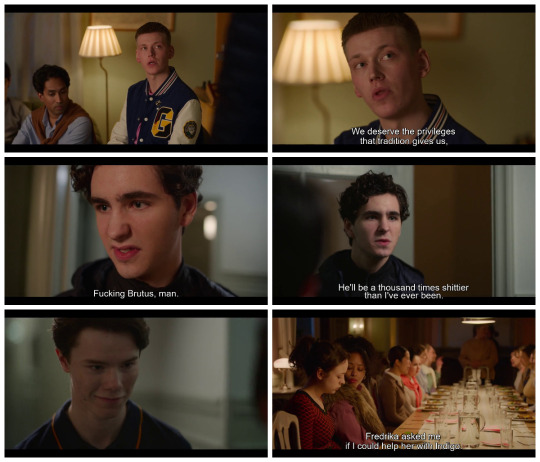
Culture: Letterman jackets or varsity jackets are absolutely not a thing in Sweden. The reason Vincent is wearing one is to show off that he has done a year as an exchange student in the US. I think the patches are completely made up, but at least I can make out the arm patch saying New Haven, which sounds on brand for Vincent given that the Ivy League university Yale is located there, which is where the US upper class sends their kids.
Subtext: Here comes The Theme again. Vincent wants to uphold the traditions of their house, but the main reason he wants to is that he was treated like shit by the third-year students when he was a first-year, so he wants to keep the privilege of being able to treat the new first-years as shit now that he is a third-year, thus perpetuating the cycle of abuse.
Subtext: Is there anyone reading this who does not know what Marcus Junius Brutus is most known for? Spoiler: He helped kill Julius Caesar by stabbing him in the back.
Subtext: Funnily enough, August is right, Vincent will be a lot shittier as prefect and captain of the rowing team.
Blink and you miss it: Villain Wilhelm smirks as his plan to depose August worked out.
Subtext: Felice and the girls all know that Felice is going to sell the horse, but they haven't told Sara, because they know how much the horse means to her. And Sara can't read social cues to save her life, so she doesn't understand why Fredrika suddenly offered her to help out and spend time with her horse instead.

Subtext: Vincent really isn't a fan of equality, so being forced to include first-year students in the competition instead of packing their team with all the strongest third-years is socialist nonsense to him.
Lost in translation: In Swedish, Vincent says "...även om ni suger dase". It means the same as the English subtitles, but it literally means "...even if you suck dick", which is a casually homophobic dig towards Simon and Wilhelm. That said, no-one in Sweden would use this expression when talking about oral sex.
Subtext: "...both mentally and physically, as you all know". Vincent's parade of awfulness shows no signs of stopping anytime soon, casual bodyshaming of Walter, throw it on the pile!
Lost in translation: In Swedish he says "som kan kötta!", which is hilariously untranslatable. It literally means to "meat" something, as in the sense of butchering, using brute force, or tearing someone to shreds. We're staying true to Vincent's douchebro brand here.
Culture: That's not a running trail, that's just a piece of random forest. It is quite common to have trails close to outdoor sporting areas like this, but I supposed there just wasn't one at this shooting location, so the show had to improvise?
Subtext: Wilhelm actually cares about keeping Simon on the team, because it's part of his plan of staying close to Simon in order to win him back, like Felice told him to. Instead he gives the lame excuse about Simon's PE grades.
Subtext: Yeah, no way this cheating plan is gonna backfire on Wilhelm, no way, no how.
Subtext: Simon avoids answering the question, because he doesn't want to tell Wilhelm about trying to move on from Marcus, so he pretends that he doesn't know know him.
244 notes
·
View notes